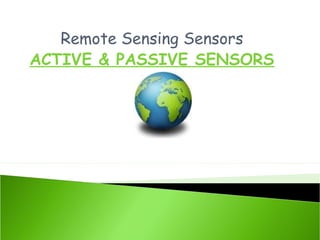
active and passive sensors
- 1. Remote Sensing Sensors ACTIVE & PASSIVE SENSORS
- 2. 1. Introduction of Remote Sensing. 2. Definition of Sensors. 3. Classification of Sensors. 4. Active & Passive Sensors. 5. Examples for Active & Passive Sensors. 6. Difference between Active & Passive Sensors. 7. Advantages & Disadvantages of Active & Passive Sensors. 8. Applications of active and passive sensors. 9. Conclusion. 10. References.
- 3. “Remote Sensing is the Science (& to the some extent, Art) of acquiring information about the earth’s surface without actually being in contact with it. This is done by sensing & recording reflected or emitted energy & processing, analyzing & applying that information.”
- 4. “A sensor is a device comprising of optical component or system and a detector with electronic circuitry that will be used to record the reflected and/or emitted energy from various objects”.
- 6. Active Sensors: Active Remote sensors create their own electromagnetic energy that is transmitted from the sensor towards the terrain, interacts with the terrain producing a backscatter of energy and is recorded by the remote sensor’s receiver. Passive Sensors: Passive sensor detects the naturally emitted microwave energy within its field of view.
- 7. 1) RADARSAT-1: Is an advanced Earth observation satellite project developed by the Canadian Space Agency (CSA) on 4th Nov 1995 to monitor environmental change & to support resource sustainability. RADARSAT Satellite A 3D view of flight path & data Radarsat image of Antarctica shown over Radarsat(600x404) (3424x2848)
- 8. 2) LISS-1: It is a multispectral instrument with a 76m resolution in 4 wavebands. A more advanced version of LISS, LISS-2 is carried by the IRS -1B satellite which was launched in 1991. LISS-1 Satellite LISS-1 Satellite image of Delhi, India LISS-1 satellite image of Surat, India (1000x1000) (1000x1000)
- 9. 1) SPOT-1: It was launched on 22nd Feb, 1986 with 10 panchromatic & 20 meter multispectral picture resolution capability. SPOT Satellite Spot satellite image of San Francisco SPOT satellite image of & the East Bay(800x717) Hong- Kong(530x523)
- 10. 2) LANDSAT-1: It was launched on 23rd July 1972, at that time the satellite was known as the Earth Resource Technology Satellite (ERTS). It was the first Earth observing satellite to be launched with the express intent to study & monitor our Planet’s Landmasses. LANDSAT-1 Satellite LANDSAT image of St.Helens LANDSAT image of Crater Lake-Caldera (2000x2000) (380x380)
- 11. Active Sensors Active transducers generate electric current or voltage directly in response to environmental stimulation. Active sensors provides their own energy source for illumination. Active sensors are able to obtain measurements anytime (Day & Night). Passive Sensors Passive transducers produce a change in some passive electrical quantity, such as capacitance, resistance, or inductance, as a result of stimulation. These usually require additional electrical energy for excitation. Passive sensors can only be used to detect energy when the naturally occurring energy is available. Passive Sensors can obtain measurements only in the Day time.
- 12. Advantages Disadvantages Better control of noise sources through control of injected signal. Because both sources and receivers are under the surveyor's control, he must supply both. Therefore, field equipment tends to be more complex Because propagating fields are generally measured, active experiments usually provide better depth control over source of anomalous signal. Field operations and logistics are generally more complex and time consuming than passive experiments. Many different source/receiver configurations can be used allowing for a wide variety of survey designs. This allows survey designers great flexibility in customizing surveys for particular problems. Many different source/receiver configurations can be used allowing for a wide variety of survey designs. The increase in the number of field options inevitably leads to greater survey design costs and potentially to increased probability of field mishaps. Once set up, active experiments are capable of producing vast quantities of data that can be used to interpret subtle details of the earth's subsurface. The large quantity of data obtained in many active experiments can become overwhelming to process and interpret.
- 13. Advantages Disadvantages Surveyor need only record a naturally occurring field; therefore, he need supply only a sensor and a data recorder. Less control of noise because source of the signal is out of the control of the surveyor. Field operations are generally very time efficient. Thus, passive experiments can be run over wider areas in a more cost-effective manner. Because passive fields are generally the result of integrating anomalous geologic contributions over wide areas, identification of the source of an anomalous reading can be difficult. One or two well-established field procedures are generally used. Contractors can provide these surveys on short notice with relatively easily quantifiable results. One or two well-established field procedures is generally used. This limits the amount of customization that can be done for specific problems. Interpretation of the limited set of observations can be accomplished with modest computational requirements quickly and efficiently. The data sets collected in passive experiments are smaller than those collected in active experiments and usually do not allow for as detailed an interpretation.
- 14. Radarsat: Imaging characteristics, mapping of vegetation, vegetated terrain and sand terrain LISS: Land use, land cover and geological aspects SPOT: Resources of earth and environmental aspects Landsat: Seasonal features like weather, atmosphere, rainfall on images
- 15. Sensor is a device comprising of optical component or system and a detector electronic circuitry used to record It is a very important component in remote sensing Active sensors are more advantageous than passive sensors LISS is one of the active sensors which is launched in Indian satellites. LISS-2 is the advanced version carried by the Indian satellite IRS-1B
- 16. FLOYD F. SABINS(1996/1997) REMOTE SENSING principles and Interpretation W.H. FREEMAN AND COMPANY NEWYORK 3rd Edition, page 29,69,105,177,236. B.Bhatta(2008) Remote sensing and GIS Oxford University press, page 442,121,129,135.144 Fundamentals of Remote Sensing A Canada Centre for Remote Sensing Tutorials Natural Resources Canada, page 5,19. Websites http://en.wikipedia.org/wiki/Radarsat-1 http://www.angelfire.com/co/pallav/sensorindia.html en.wikipedia.org/wiki/SPOT_(satellite) nsidc.org/data/radarsat/pdfs/RADARSAT1.pdf galitzin.mines.edu/INTROGP/notes_te…
